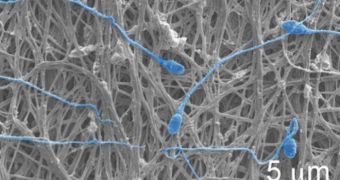A double-efficient condom that prevents pregnancy and HIV at the same time in the most efficient and versatile manner ever known has been developed by a group of researchers at the University of Washington.
The new concept consists of a condom made out of electrospun fibers that can dissolve and release drugs inside the body or be a physical block for the sperm.
“Our dream is to create a product women can use to protect themselves from HIV infection and unintended pregnancy,” declared Kim Woodrow, a professor of bioengineering at the University of Washington and head-leader of the study.
“We have the drugs to do that. It’s really about delivering them in a way that makes them more potent, and allows a woman to want to use it.”
The project has recently been granted $1 million (€0.77 million) by the Bill&Melissa Gates Foundation in order for the concept first presented last year at a laboratory meeting, to be put in practice, University of Washington reports.
The electrospinning mechanism consists of a nanometer-sized set of fibers generated as a consequence of an electric field throwing a charged liquid into air. The fibers are very versatile, allowing the manipulation of its resistance, shape and solubility. This characteristic turns the device into the best drug-releaser: better than traditional techniques such as tablets, pills or gels.
“This method allows controlled release of multiple compounds. We were able to tune the fibers to have different release properties,” explained co-author of the study Cameron Ball.
The fabric can be projected as to dissolve immediately, for an efficient contraception, or it can be set for a-few-day-term dissolution, as to ensure a longer pregnancy and HIV protection.
Despite the higher rate of comfort and efficiency it provides, doctors say they cannot firmly declare it as the only method to always be used.
“At the time of [intimate relations], are people going to actually use it? That’s where having multiple options really comes into play,” said Emily Krogstad, professor at the University of Washington and co-author of the study.
“Depending on cultural background and personal preferences, certain populations may differ in terms of what form of technology makes the most sense for them,” she added.
The research was recently published in the PloS One journal of Public Library of Science.

 14 DAY TRIAL //
14 DAY TRIAL //